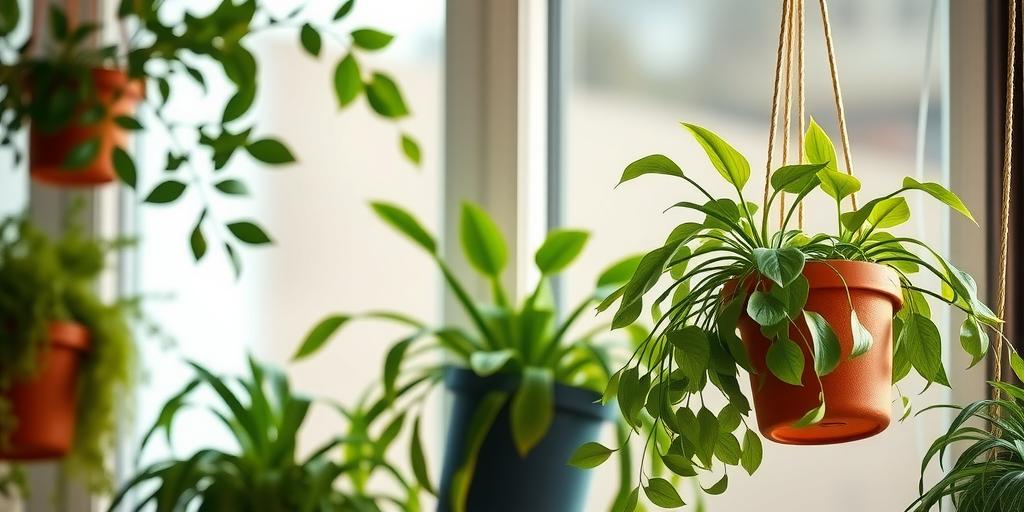
Low Maintenance Hanging Plants Perfect for Beginners: Easy & Stunning Choices
Discover the best low-maintenance hanging plants for beginners! These easy-care, beautiful plants thrive with minimal effort—perfect for busy plant lovers.
Introduction
Do you love the idea of lush, cascading greenery but worry about keeping plants alive? You’re not alone! Many beginners hesitate to bring home hanging plants, fearing they’ll need constant care. But guess what? Plenty of stunning varieties thrive on neglect! From the hardy spider plant to the drought-tolerant string of pearls, we’ve rounded up the easiest low-maintenance hanging plants that even the busiest beginner can grow. Let’s dive in!
Why Choose Low Maintenance Hanging Plants?
If you’re new to plant parenting or simply don’t have the time for high-maintenance greenery, low-maintenance hanging plants are a fantastic choice. They thrive with minimal attention, making them perfect for beginners or anyone with a busy schedule.
These plants don’t just survive—they enhance your space effortlessly. Whether indoors or outdoors, their trailing vines and lush foliage add a touch of nature without demanding constant care. Plus, many of them help purify the air, creating a healthier and more calming environment.
Top Low Maintenance Hanging Plants for Beginners
1. Spider Plant (Chlorophytum comosum)
Spider plants are practically indestructible, which is why they’re a favorite among beginners. They thrive in indirect light, so a spot near a bright window (but out of direct sun) is ideal.
One of their best features? They produce “pups”—tiny offshoots that you can easily propagate to grow more plants. Plus, they’re excellent at filtering indoor air pollutants, making them as functional as they are beautiful.
2. Pothos (Epipremnum aureum)
Pothos is another superstar in the low-maintenance category. It can grow in anything from low light to bright, indirect light, though its variegation (like in Golden or Marble Queen varieties) may fade in dim conditions.
Watering is simple—just wait until the soil feels dry to the touch. Pothos trails beautifully, making it perfect for hanging baskets where its vines can cascade down. With so many varieties to choose from, you can easily find one that matches your decor.
3. String of Pearls (Senecio rowleyanus)
If you love unique plants, the String of Pearls is a must-have. Its bead-like foliage drapes elegantly, creating a striking visual effect. It prefers bright, indirect light but can tolerate some direct sun.
Since it’s a succulent, it’s highly drought-tolerant—perfect if you occasionally forget to water. It works well in boho or modern spaces, adding a whimsical touch to shelves or hanging planters.
4. Heartleaf Philodendron (Philodendron hederaceum)
Heartleaf Philodendron is as charming as it is easy to care for. Its heart-shaped leaves bring a soft, romantic vibe to any space. It adapts well to low-light conditions, though it grows faster in brighter spots.
This plant is forgiving if you miss a watering or two, and it’s rarely bothered by pests. Its trailing vines make it ideal for hanging baskets or training along shelves.
5. Burro’s Tail (Sedum morganianum)
Burro’s Tail is a succulent with thick, trailing stems covered in plump, blue-green leaves. It loves bright light but can handle some shade, making it versatile for different spots in your home.
The key to keeping it happy? Water sparingly. Overwatering can lead to root rot, so let the soil dry out completely between waterings. Its unique appearance adds a playful, whimsical element to any space.
Essential Care Tips for Hanging Plants
Light Requirements
Most hanging plants prefer bright, indirect sunlight. Direct sun can scorch their leaves, while too little light may slow their growth or cause leggy vines. Observe your plant’s response—if leaves yellow or drop, it might need more light.
Watering
Overwatering is the fastest way to kill a hanging plant. Always check the soil before watering—stick your finger in about an inch deep. If it feels dry, it’s time to water. If not, wait a few more days.
Soil
A well-draining potting mix is crucial. Many hanging plants, especially succulents like String of Pearls and Burro’s Tail, need soil that doesn’t hold excess moisture. Adding perlite or sand can improve drainage.
Fertilizing
During the growing season (spring and summer), a light feeding every 4-6 weeks helps keep your plants lush. Use a balanced liquid fertilizer diluted to half strength to avoid overfeeding.
Pruning
Regular trimming encourages bushier growth and prevents your plant from becoming too sparse. Simply snip off leggy vines or dead leaves to maintain a full, healthy appearance.
Best Places to Hang Your Plants
Near Bright Windows
Most hanging plants thrive near windows with filtered light. East or north-facing windows are ideal for indirect light, while south or west-facing windows may need sheer curtains to soften harsh rays.
Bathrooms
If you have a bathroom with natural light, humidity-loving plants like Pothos or Heartleaf Philodendron will flourish there. The extra moisture in the air mimics their natural tropical environment.
Patios or Balconies
For outdoor-friendly varieties like Spider Plants or Burro’s Tail, a covered patio or balcony provides the perfect spot. Just ensure they’re protected from extreme weather.
Shelves or Macramé Hangers
Hanging plants add instant style to any room. Place them above shelves for a cascading effect or use macramé hangers to create a bohemian vibe.
Common Mistakes to Avoid
Overwatering
This is the #1 killer of houseplants. Always check the soil before watering, and remember—most hanging plants prefer to dry out slightly between waterings.
Wrong Light Conditions
Placing a low-light plant in direct sun (or vice versa) can stress it. Research your plant’s needs and adjust its location if you notice signs of distress.
Ignoring Pest Checks
Spider mites, mealybugs, and aphids can sneak up on your plants. Regularly inspect leaves (especially the undersides) and treat infestations early with insecticidal soap or neem oil.
Using Pots Without Drainage
Without drainage holes, excess water has nowhere to go, leading to root rot. Always choose pots with holes or drill them yourself if needed. A saucer underneath catches runoff and protects surfaces.
Conclusion
Low-maintenance hanging plants are the perfect way to bring life into your space without the stress of constant care. Whether you opt for a resilient pothos or a quirky string of pearls, these beginner-friendly plants will thrive with minimal effort. Ready to transform your home into a green oasis? Pick your favorite and let it grow!
